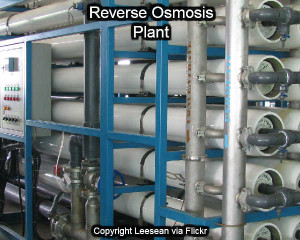 When leachate must be treated to a very high standard for watercourse discharges which require not only for the reactive components of leachate to be removed but also require non-reactive compounds to be removed such as the sodium chloride, which is always elevated in MSW landfill leachate, the technology of Reverse Osmosis may be the only way to achieve treatment and disposal, other than disposal to the atmosphere.
When leachate must be treated to a very high standard for watercourse discharges which require not only for the reactive components of leachate to be removed but also require non-reactive compounds to be removed such as the sodium chloride, which is always elevated in MSW landfill leachate, the technology of Reverse Osmosis may be the only way to achieve treatment and disposal, other than disposal to the atmosphere.
Distillation or evaporation are “disposal to the atmosphere options” and are the only alternatives to RO in such circumstances. But, distillation is not normally affordable due to the high energy input required to boil water, and passive evaporation to the atmosphere is only feasible in hot countries which have a suitably low rainfall. This just leaves Reverse Osmosis as the only viable option in such cases.
The Reverse Osmosis method removes the organic matter and the mineral content as well. It is often used after aeration treatment (either for nitrification alone or nitrification combined with denitrification), and nanofiltration, and will remove the nitrate created during nitrification which occurs during aeration, which produces a nitrogenous effluent upstream, and these salts are dissolved. Dissolved salts are not stopped by the larger pore sizes of the preceding micro-filtration or nanofiltration stages (where those stages are present) as part of a membrane bioreactor (MBR), but they are held back by RO membranes.
Reverse osmosis also provides the removal of heavy metals as well as the salts like chloride, sodium, potassium, already mentioned and which are found in high concentrations in the leachate.
Reverse osmosis (RO) uses the properties of semi-permeable membranes, through which water migrates, and as it passes through all the particles which were in solution are trapped, except for those organic particles that have a molecular mass very close to the molecular mass of water.
The Physics Behind Reverse Osmosis Technology
In reverse osmosis, energy is used to create a pressure which reverses the normal flow across a membrane where flow normally occurs from the more dilute fluid on one side of the membrane into the more concentrated solution on the other side of the membrane.
The osmotic pressure, in normal circumstances, is the result of the water flowing through the semi-permeable membrane, from the less concentrated compartment to the most concentrated compartment. When that happens the osmotic pressure is directly proportional to the difference of the concentrations.
The operation pressure of the reverse osmosis unit, in the case of leachate treatment, must, therefore, be greater than the osmotic pressure, so as to overcome the natural pressure and make the water flow in the opposite direction, through the membrane from the most concentrated compartment (leachate to be treated) to the less concentrated compartment (treated water).
The conversion rate (Cr) is the ratio of the flow of treated leachate (Ft) over the flow of raw leachate (Fr) (Ft is the result of the leachate treated by the membrane bioreactor).
Cr = (Ft.lOO)/(Fr), in %.
As a result, the flow of brine is the difference between the flow of raw leachate and the flow of treated leachate : Fb = Fr – Ft.
The concentration factor is the ratio of raw leachate over treated leachate : Cf = Fr/Ft.
In RO treatment the outcome of the filtration treatment is to minimize the volume of brine that will have to be treated, and therefore to work with a conversion rate as high as possible is best.
However, this conversion rate is limited first by the solubility factor of the main salts contained by the leachate (their precipitation would impair the running of the membranes), and secondly by the osmotic pressure developed by the concentrated leachate (that must be much lower than the maximum pressure allowed by the membrane).
In order to limit the salt precipitation, an acidification dosing stage must be included, and a dosing system continuously measures the flow of the “concentrate” and output of the membrane bioreactor treated leachate, before being pumped to the reverse osmosis membranes.
The clogging of the membranes is controlled by applying adequate shear strength on the surface of the membranes, with the recirculation pump. Declogging is regularly done by automatic flushing out of the recirculation network, or by chemical washing.
The reverse osmosis permeate is collected and stored for a short period of time before being returned to the environment.





The RO brine can be treated by a leachate crystallizer for true zero liquid discharge:
http://www.saltworkstech.com/landfill-leachate/
http://www.saltworkstech.com/food-and-beverage-industrial-wastewater-treatment/